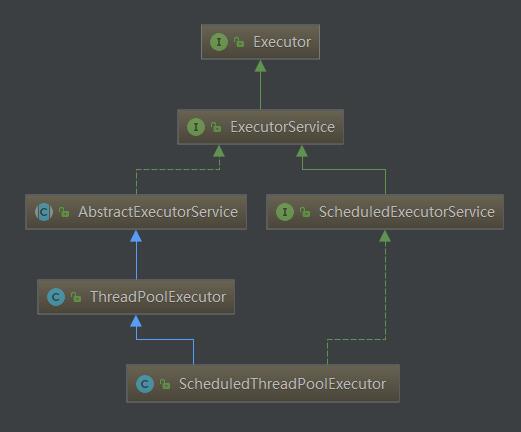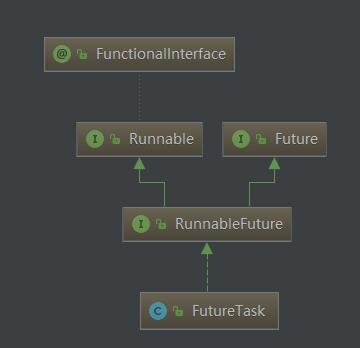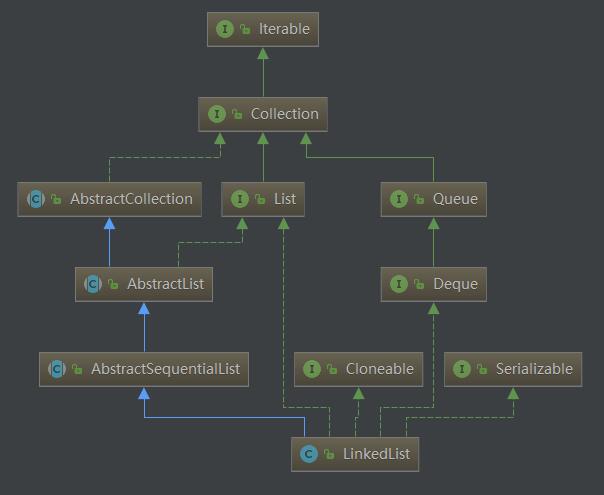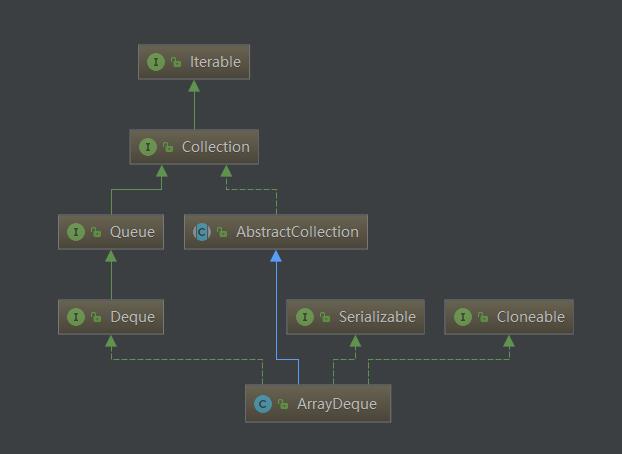36 KiB
CountDownLatch的用法
CountDownLatch 是一个同步工具类,用来协调多个线程之间的同步,或者说起到线程之间的通信。
如果想当前线程在别的线程执行完毕后执行,可以使用CountDownLatch。
/**<p><b>Sample usage:</b> Here is a pair of classes in which a group
* of worker threads use two countdown latches:
* <ul>
* <li>The first is a start signal that prevents any worker from proceeding
* until the driver is ready for them to proceed;
* <li>The second is a completion signal that allows the driver to wait
* until all workers have completed.
* </ul>
*
* <pre> {@code
* class Driver { // ...
* void main() throws InterruptedException {
* CountDownLatch startSignal = new CountDownLatch(1);
* CountDownLatch doneSignal = new CountDownLatch(N);
*
* for (int i = 0; i < N; ++i) // create and start threads
* new Thread(new Worker(startSignal, doneSignal)).start();
*
* doSomethingElse(); // don't let run yet
* startSignal.countDown(); // let all threads proceed
* doSomethingElse();
* doneSignal.await(); // wait for all to finish
* }
* }
*
* class Worker implements Runnable {
* private final CountDownLatch startSignal;
* private final CountDownLatch doneSignal;
* Worker(CountDownLatch startSignal, CountDownLatch doneSignal) {
* this.startSignal = startSignal;
* this.doneSignal = doneSignal;
* }
* public void run() {
* try {
* startSignal.await();
* doWork();
* doneSignal.countDown();
* } catch (InterruptedException ex) {} // return;
* }
*
* void doWork() { ... }
* }}</pre>
线程创建
线程创建通常有3中方法:
- 继承 Thread 类
- 实现 Runnable 接口
- 实现 Callable 接口
实现 Runnable 接口来创建一个线程:
public class MyThread extends Thread {
public static void main(String[] args) {
Thread t1 = new MyThread();
t1.start();
Thread t2 = new Thread(new MyThread2());
t2.start();
Callable call = new MyCallable();
FutureTask<String> task = new FutureTask<String>(call);
Thread t3 = new Thread(task);
t3.start();
}
@Override
public void run() {
System.out.println("线程运行中---------extends");
}
static class MyThread2 implements Runnable{
@Override
public void run() {
System.out.println("线程运行中------runnable");
}
}
static class MyCallable implements Callable{
@Override
public String call() throws Exception {
System.out.println("线程运行中------callable");
return "call over!";
}
}
}
线程间协作
join
在线程中调用另一个线程的 join() 方法,会将当前线程挂起,而不是忙等待,直到目标线程结束。
对于以下代码,虽然 b 线程先启动,但是因为在 b 线程中调用了 a 线程的 join() 方法,b 线程会等待 a 线程结束才继续执行,因此最后能够保证 a 线程的输出先于 b 线程的输出。
public class JoinExample {
public static void main(String[] args) {
JoinExample example = new JoinExample();
example.test();
}
private class A extends Thread {
@Override
public void run() {
System.out.println("A");
}
}
private class B extends Thread {
private A a;
B(A a) {
this.a = a;
}
@Override
public void run() {
try {
a.join();
} catch (InterruptedException e) {
e.printStackTrace();
}
System.out.println("B");
}
}
public void test() {
A a = new A();
B b = new B(a);
b.start();
a.start();
}
}
wait
wait 方法会使得当前线程进入等待状态,使用 wait() 挂起期间,线程会释放锁。这是因为,如果没有释放锁,那么其它线程就无法进入对象的同步方法或者同步控制块中,那么就无法执行 notify() 或者 notifyAll() 来唤醒挂起的线程,造成死锁。
wait() 和 sleep() 的区别
- wait() 是 Object 的方法,而 sleep() 是 Thread 的静态方法;
- wait() 会释放锁,sleep() 不会。
interrupt
线程中断的方法有两种:
- 使用 interrupted()来作为线程循环执行的判断条件
public class InterruptExample {
private static class MyThread2 extends Thread {
@Override
public void run() {
while (!interrupted()) {
// ..
}
System.out.println("Thread end");
}
}
}
- 使用InterruptedException
通过调用一个线程的 interrupt() 来中断该线程,如果该线程处于阻塞、限期等待或者无限期等待状态,那么就会抛出 InterruptedException,从而提前结束该线程。但是不能中断 I/O 阻塞和 synchronized 锁阻塞
对于以下代码,在 main() 中启动一个线程之后再中断它,由于线程中调用了 Thread.sleep() 方法,因此会抛出一个 InterruptedException,从而提前结束线程,不执行之后的语句。
public class InterruptExample {
private static class MyThread1 extends Thread {
@Override
public void run() {
try {
Thread.sleep(2000);
System.out.println("Thread run");
} catch (InterruptedException e) {
e.printStackTrace();
}
}
}
}
public static void main(String[] args) throws InterruptedException {
Thread thread1 = new MyThread1();
thread1.start();
thread1.interrupt();
System.out.println("Main run");
}
Condition
java.util.concurrent 类库中提供了 Condition 类来实现线程之间的协调,可以在 Condition 上调用 await() 方法使线程等待,其它线程调用 signal() 或 signalAll() 方法唤醒等待的线程。相比于 wait() 这种等待方式,await() 可以指定等待的条件,因此更加灵活。
public class AwaitSignalExample {
private Lock lock = new ReentrantLock();
private Condition condition = lock.newCondition();
public void before() {
lock.lock();
try {
System.out.println("before");
condition.signalAll();
} finally {
lock.unlock();
}
}
public void after() {
lock.lock();
try {
condition.await();
System.out.println("after");
} catch (InterruptedException e) {
e.printStackTrace();
} finally {
lock.unlock();
}
}
}
Executor 框架
Executor 框架主要由3大部分组成,如下:
- 任务
被执行的任务需要实现 Runnable 或者 Callable接口
- 任务的执行
任务执行的核心接口 Executor, 以及继承自 Executor 的 ExecutorService 接口。 Executor 框架有两个关键类实现了 ExecutorService 接口(ThreadPoolExecutor 和 ScheduledThreadPoolExecutor)
- 异步计算的结果
Future 接口和 FutureTask 类
Executor 主要的类和接口
| 类和接口 | 说明 |
|---|---|
| Executor | 一个接口,其定义了一个接收Runnable对象的方法executor,其方法签名为executor(Runnable command), Executor 框架的基础,它将任务的提交和任务的执行分离开来 |
| ExecutorService | 是一个比Executor使用更广泛的子类接口,其提供了生命周期管理的方法,以及可跟踪一个或多个异步任务执行状况返回Future的方法 |
| AbstractExecutorService | ExecutorService执行方法的默认实现 |
| ThreadPoolExecutor | 线程池的核心实现类,用来执行被提交的任务。通过调用Executors以下静态工厂方法来创建线程池并返回一个ExecutorService对象 |
| ScheduledExecutorService | 一个可定时调度任务的接口 |
| ScheduledThreadPoolExecutor | ScheduledExecutorService 的实现类, 可以在给定的延迟后运行命令,或者定期执行命令, 比 Timer更加灵活,功能更加强大。 |
ThreadPoolExecutor
ThreadPoolExecutor 使用 Executors来创建,提供了4种类型的ThreadPoolExectuor, 分别是 newFixedThreadPool 、 newSingleThreadExecutor 、newScheduledThreadPool、 newCachedThreadPool.
- 构造函数
/**
* Creates a new {@code ThreadPoolExecutor} with the given initial
* parameters.
*
* @param corePoolSize the number of threads to keep in the pool, even
* if they are idle, unless {@code allowCoreThreadTimeOut} is set
* @param maximumPoolSize the maximum number of threads to allow in the
* pool
* @param keepAliveTime when the number of threads is greater than
* the core, this is the maximum time that excess idle threads
* will wait for new tasks before terminating.
* @param unit the time unit for the {@code keepAliveTime} argument
* @param workQueue the queue to use for holding tasks before they are
* executed. This queue will hold only the {@code Runnable}
* tasks submitted by the {@code execute} method.
* @param threadFactory the factory to use when the executor
* creates a new thread
* @param handler the handler to use when execution is blocked
* because the thread bounds and queue capacities are reached
* @throws IllegalArgumentException if one of the following holds:<br>
* {@code corePoolSize < 0}<br>
* {@code keepAliveTime < 0}<br>
* {@code maximumPoolSize <= 0}<br>
* {@code maximumPoolSize < corePoolSize}
* @throws NullPointerException if {@code workQueue}
* or {@code threadFactory} or {@code handler} is null
*/
public ThreadPoolExecutor(int corePoolSize,
int maximumPoolSize,
long keepAliveTime,
TimeUnit unit,
BlockingQueue<Runnable> workQueue,
ThreadFactory threadFactory,
RejectedExecutionHandler handler)
参数说明:
corePoolSize:核心线程数,如果运行的线程少于corePoolSize,则创建新线程来执行新任务,即使线程池中的其他线程是空闲的
maximumPoolSize:最大线程数,可允许创建的线程数,corePoolSize和maximumPoolSize设置的边界自动调整池大小: corePoolSize <运行的线程数< maximumPoolSize:仅当队列满时才创建新线程 corePoolSize=运行的线程数= maximumPoolSize:创建固定大小的线程池
keepAliveTime:如果线程数多于corePoolSize,则这些多余的线程的空闲时间超过keepAliveTime时将被终止
unit:keepAliveTime参数的时间单位
workQueue:保存任务的阻塞队列,与线程池的大小有关: 当运行的线程数少于corePoolSize时,在有新任务时直接创建新线程来执行任务而无需再进队列 当运行的线程数等于或多于corePoolSize,在有新任务添加时则选加入队列,不直接创建线程 当队列满时,在有新任务时就创建新线程
threadFactory:使用ThreadFactory创建新线程,默认使用defaultThreadFactory创建线程
handle:定义处理被拒绝任务的策略,默认使用ThreadPoolExecutor.AbortPolicy,任务被拒绝时将抛出RejectExecutorException
newFixedThreadPool
创建可重用且固定线程数的线程池,如果线程池中的所有线程都处于活动状态,此时再提交任务就在队列中等待,直到有可用线程;如果线程池中的某个线程由于异常而结束时,线程池就会再补充一条新线程。
public static ExecutorService newFixedThreadPool(int nThreads) {
return new ThreadPoolExecutor(nThreads, nThreads,
0L, TimeUnit.MILLISECONDS,
//使用一个基于FIFO排序的阻塞队列,在所有corePoolSize线程都忙时新任务将在队列中等待
new LinkedBlockingQueue<Runnable>());
}
newSingleThreadExecutor
创建一个单线程的Executor,如果该线程因为异常而结束就新建一条线程来继续执行后续的任务
public static ExecutorService newSingleThreadExecutor() {
return new FinalizableDelegatedExecutorService
//corePoolSize和maximumPoolSize都等于,表示固定线程池大小为1
(new ThreadPoolExecutor(1, 1,
0L, TimeUnit.MILLISECONDS,
new LinkedBlockingQueue<Runnable>()));
}
newScheduledThreadPool
创建一个可延迟执行或定期执行的线程池
/**
* Creates a new {@code ScheduledThreadPoolExecutor} with the
* given core pool size.
*
* @param corePoolSize the number of threads to keep in the pool, even
* if they are idle, unless {@code allowCoreThreadTimeOut} is set
* @throws IllegalArgumentException if {@code corePoolSize < 0}
*/
public ScheduledThreadPoolExecutor(int corePoolSize) {
super(corePoolSize, Integer.MAX_VALUE,
DEFAULT_KEEPALIVE_MILLIS, MILLISECONDS,
new DelayedWorkQueue());
}
使用 scheduledThread 来模拟心跳:
public class HeartBeat {
public static void main(String[] args) {
ScheduledExecutorService executor = Executors.newScheduledThreadPool(5);
Runnable task = new Runnable() {
public void run() {
System.out.println("HeartBeat.........................");
}
};
executor.scheduleAtFixedRate(task,5,3, TimeUnit.SECONDS); //5秒后第一次执行,之后每隔3秒执行一次
}
}
newCachedThreadPool
创建可缓存的线程池,如果线程池中的线程在60秒未被使用就将被移除,在执行新的任务时,当线程池中有之前创建的可用线程就重用可用线程,否则就新建一条线程
public static ExecutorService newCachedThreadPool() {
return new ThreadPoolExecutor(0, Integer.MAX_VALUE,
60L, TimeUnit.SECONDS,
//使用同步队列,将任务直接提交给线程
new SynchronousQueue<Runnable>());
}
例子:
public class ThreadPoolTest {
public static void main(String[] args) throws InterruptedException {
ExecutorService threadPool = Executors.newCachedThreadPool();//线程池里面的线程数会动态变化,并可在线程线被移除前重用
for (int i = 1; i <= 3; i ++) {
final int task = i; //10个任务
TimeUnit.SECONDS.sleep(1);
threadPool.execute(new Runnable() { //接受一个Runnable实例
public void run() {
System.out.println("线程名字: " + Thread.currentThread().getName() + " 任务名为: "+task);
}
});
}
}
}
输出:(为每个任务新建一条线程,共创建了3条线程) 线程名字: pool-1-thread-1 任务名为: 1 线程名字: pool-1-thread-2 任务名为: 2 线程名字: pool-1-thread-3 任务名为: 3 去掉第6行的注释其输出如下:(始终重复利用一条线程,因为newCachedThreadPool能重用可用线程) 线程名字: pool-1-thread-1 任务名为: 1 线程名字: pool-1-thread-1 任务名为: 2 线程名字: pool-1-thread-1 任务名为: 3
Future 接口
Future 接口和实现了Future接口的FutureTask类用来表示异步计算的结果。当我们把Runnable 或者 Callable 接口的实现类提交给ThreadPoolExecutor时,Exector会返回给FutureTask对象
ScheduledThreadPoolExecutor
ScheduledThreadPoolExecutor 继承自 ThreadPoolExecutor, 主要用来在给定的延迟后运行任务。 主要包含3个成员变量:
- long: time ; 表示这个任务将要被执行的具体时间
- long: sequenceNumber; 表示这个任务被添加到SheduledThreadPoolExecutor 中的序号
- long:period; 表示任务执行的间隔周期
该类采用了DelyQueue,封装了一个优先队列,该队列会对队列中的SheduledFutureTask 进行排序。time小的会排在前面,如果time相同,则会比较sequenceNumber, 就是说如果两个任务的执行时间相同,谁先提交就谁先执行
ThreadLocal
变量值的共享可以采用public static 的类变量,但是在多线程情况下,static 类变量显然不能满足多线程的读写,因此采用ThreadLocal 变量来存储多线程下的变量的副本。
/*
* Copyright (c) 2018. Xiong Raorao. All rights reserved.
* Project Name: book-notes
* File Name: Test.java
* Date: 18-7-25 下午5:32
* Author: Xiong Raorao
*/
package com.raorao.java.thread;
/**
* .
*
* @author Xiong Raorao
* @since 2018-07-25-17:32
*/
public class ThreadLocalTest {
private static ThreadLocal<Integer> local = new ThreadLocal<>();
public static void main(String[] args) throws InterruptedException {
Thread t1 = new Thread(() -> {
System.out.println(" I am t1");
local.set(1);
try {
Thread.sleep(2000);
System.out.println("t1 value: " + local.get());
} catch (InterruptedException e) {
e.printStackTrace();
}
});
Thread.sleep(2000);
Thread t2 = new Thread(() -> {
System.out.println("I am t2");
System.out.println("before set , I get " + local.get());
try {
Thread.sleep(2000);
local.set(2);
System.out.println("set after 2 s, I get " + local.get());
} catch (InterruptedException e) {
e.printStackTrace();
}
});
t2.start();
t1.start();// 无论怎么更换两个线程的启动顺序,得到的值是不一样的
}
}
Lock
除了使用synchronized 关键字加锁同步之外,也可以实现Lock 来自定义同步过程。
Synchronized
jvm提供的一种互斥同步锁的方式
synchronized 可以作用于代码块,方法,类方法,类等,锁加载的
ReentrantLock
public class LockExample {
private Lock lock = new ReentrantLock();
public void func() {
lock.lock();
try {
for (int i = 0; i < 10; i++) {
System.out.print(i + " ");
}
} finally {
lock.unlock(); // 确保释放锁,从而避免发生死锁。
}
}
public static void main(String[] args) {
LockExample lockExample = new LockExample();
ExecutorService executorService = Executors.newCachedThreadPool();
executorService.execute(() -> lockExample.func());
executorService.execute(() -> lockExample.func());
}
}
输出:
0 1 2 3 4 5 6 7 8 9 0 1 2 3 4 5 6 7 8 9
synchronized 和 ReentrantLock的比较:
- 锁的实现
synchronized 是 JVM 实现的,而 ReentrantLock 是 JDK 实现的。
- 性能
新版本 Java 对 synchronized 进行了很多优化,例如自旋锁等,synchronized 与 ReentrantLock 大致相同。
- 等待可中断
当持有锁的线程长期不释放锁的时候,正在等待的线程可以选择放弃等待,改为处理其他事情。
ReentrantLock 可中断,而 synchronized 不行。
- 公平锁
公平锁是指多个线程在等待同一个锁时,必须按照申请锁的时间顺序来依次获得锁。
synchronized 中的锁是非公平的,ReentrantLock 默认情况下也是非公平的,但是也可以是公平的。
- 锁绑定多个条件
一个 ReentrantLock 可以同时绑定多个 Condition 对象。
ReentranceLock 几个特殊的方法
getHoldCount(): 查询当前线程保持此锁的个数 getQueueLength(): 返回正在等待获取次锁定的估计线程数。比如有5个线程,其中1个线程执行await()方法,调用该方法就返回4 getWaitQueueLength(): 返回等待与此锁定相关的给定条件Condition的线程估计数。
hasQueuedThread(Thread t): 查询指定线程是否正在等待获取此锁定 hasQueuedThreads(): 查询是否有线程正在等待获取此锁定 hasWaiters(Condition condition): 查询是否有线程正在等待与次锁定有关的condition条件
ReentranceReadWriteLock
ReentranceLock 是完全互斥锁,同一时间,只有同一个线程在执行ReentrantLock.lock()后面的任务,虽然安全,但是效率低下。
ReentranceReadWriteLock(读写锁),读锁是共享锁,多个读锁之间不互斥,读锁和写锁之间互斥,写锁和写锁之间互斥。
package com.raorao.java.thread;
import java.util.concurrent.locks.ReentrantReadWriteLock;
/**
* 读写锁测试.
*
* @author Xiong Raorao
* @since 2018-08-06-11:48
*/
public class ReentrantReadWriteLockTest {
private ReentrantReadWriteLock lock = new ReentrantReadWriteLock();
public void read(){
lock.readLock().lock(); // 读锁
System.out.println("获得读锁 " + Thread.currentThread().getName() + " " + System.currentTimeMillis());
try {
Thread.sleep(2000);
} catch (InterruptedException e) {
e.printStackTrace();
}finally {
lock.readLock().unlock();
}
}
public void write(){
lock.writeLock().lock(); // 写锁
System.out.println("获得写锁 " + Thread.currentThread().getName() + " " + System.currentTimeMillis());
try {
Thread.sleep(2000);
} catch (InterruptedException e) {
e.printStackTrace();
}finally {
lock.writeLock().unlock();
}
}
public static void main(String[] args) {
// 1. 读读共享, A 和 B 同时获得锁
ReentrantReadWriteLockTest test = new ReentrantReadWriteLockTest();
Thread t1 = new Thread(()-> {
Thread.currentThread().setName("A");
test.read();
});
Thread t2 = new Thread(()-> {
Thread.currentThread().setName("B");
test.read();
});
t1.start();
t2.start();
// 2. 写写互斥, D线程比C线程落后两秒执行
t1 = new Thread(()->{
Thread.currentThread().setName("C");
test.write();
});
t2 = new Thread(()->{
Thread.currentThread().setName("D");
test.write();
});
t1.start();
t2.start();
}
}
读写和写读两个锁也是互斥的,这里就不测试了。
condition
condition 可以用于实现线程wait 和 notify,主要的方法有await()、signal() 和 signalAll() 方法,对应Object 类的 wait(), notify() 和notifyAll()方法,区别是,前者只会通知持有锁的在等待的对象,后者则是对所有等待的线程通知,效率低下
package com.raorao.java.thread;
import java.util.concurrent.locks.Condition;
import java.util.concurrent.locks.Lock;
import java.util.concurrent.locks.ReentrantLock;
/**
* 可重入锁测试.
*
* @author Xiong Raorao
* @since 2018-08-06-10:27
*/
public class ReentrantLockTest {
private Lock lock = new ReentrantLock();
private Condition conditionA = lock.newCondition();
private Condition conditionB = lock.newCondition();
public static void main(String[] args) throws InterruptedException {
ReentrantLockTest test = new ReentrantLockTest();
new Thread(() -> test.testLock()).start();
new Thread(() -> test.testLock()).start();
Thread t = new Thread(() -> test.awaitA());
t.start();
Thread.sleep(2000);
test.signalA();
}
public void awaitA() {
lock.lock();
try {
System.out.println("before awaitA at " + System.currentTimeMillis());
conditionA.await(); // 在此之前必须获得锁,不然报错illegalMonitorStateException 错误
System.out.println("after awaitA at " + System.currentTimeMillis());
} catch (InterruptedException e) {
e.printStackTrace();
} finally {
lock.unlock();
System.out.println(" 释放锁 awaitA ");
}
}
public void signalA() {
lock.lock();
try {
System.out.println("signalA at " + System.currentTimeMillis());
conditionA.signal(); // 在此之前必须获得锁,不然报错illegalMonitorStateException 错误
System.out.println("signalA over at " + System.currentTimeMillis());
} finally {
lock.unlock();
System.out.println(" 释放锁 signalA ");
}
}
public void testLock() {
lock.lock();
for (int i = 0; i < 5; i++) {
System.out.print(i + " ");
}
System.out.println();
lock.unlock();
}
}
上面的程序对应的是利用Condition的进行等待和通知。
公平锁和非公平锁
公平锁:线程获取锁的顺序使按照线程加锁的顺序来分配的,满足FIFO 非公平锁:等待线程抢占获取锁,也有可能造成某个线程一直获取不到锁
ReentrantLock 构造函数输入可以设置是否是公平锁,默认非公平锁。
Timer
Timer 定时器,主要负责计划任务的功能,也就是在指定的时间开始执行某一个任务。
shedule(TimerTask task, Date date)
package com.raorao.java.thread;
import java.text.ParseException;
import java.text.SimpleDateFormat;
import java.util.Date;
import java.util.Timer;
import java.util.TimerTask;
/**
* 定时器.
*
* @author Xiong Raorao
* @since 2018-08-06-13:07
*/
public class TimerTest {
private static Timer timer = new Timer();
static class MyTask extends TimerTask{
@Override
public void run() {
System.out.println("运行时间: " + new Date());
}
}
public static void main(String[] args) {
MyTask task1 = new MyTask();
try {
Date taskDate = new SimpleDateFormat("yyyy-MM-dd HH:mm:ss").parse("2018-08-06 13:15:00");
System.out.println("执行时间: " + taskDate.toLocaleString() + ",当前时间" + new Date().toLocaleString());
timer.schedule(task1, taskDate);
} catch (ParseException e) {
e.printStackTrace();
}
}
}
输出:
执行时间: 2018-8-6 13:15:00,当前时间2018-8-6 13:14:27 运行时间: Mon Aug 06 13:15:00 CST 2018
如果任务执行时间比当前时间晚,则到了计划时间执行,否则立即执行。
shedule 周期性执行
函数: shedule(TimeTask task, Date firstTime, long period) 表示在指定的日期之后,按照指定的时间间隔(period)周期性的无休止的执行某一任务。
同样满足如果是未来的任务,到计划时间执行,否则立即执行
sheduleAtFixedRate
该方法和shedule方法的区别在于任务不延迟的情况。
shedule: 如果执行任务的时间没有被延迟,那么下一次任务的执行时间参考的是上一次任务的“开始”时间计算。
sheduleAtFixedRate: 如果执行任务的时间没有被延迟,那么下一次任务的执行时间参考的是上一次任务的“结束”时间计算。
Concurrent 容器
BlockingQueue
BlockingQueue 是一个阻塞接口,定义了阻塞队列的行为。
- boolean add(E e): 对尾插入元素,成功返回true;
- boolean offer(E e): 队尾插入元素,成功返回true; 和 add 区别在于,如果超过队列容量,add 会抛出 IllegalStateException 异常
- void put(E e): 队尾插入元素,如果在线程等待的时候发生线程中断,抛出异常。
- boolean offer(E e, long timeout, TimeUnit unit): 超时放弃,线程等待的时候如果发生中断信号,也会抛出中断异常。
- E take(): 弹出队头元素,线程等待的时候如果发生中断信号,也会抛出中断异常。
- E remove(): 弹出队头元素, 如果为空,抛出NoSuchElementException;
- E poll(): 弹出队头元素,如果为空,返回null
- E poll(long timeout, TimeUnit unit): 超时放弃,线程等待的时候如果发生中断信号,抛出异常。
- E element(): 仅仅返回对头元素, 如果为空,抛出NoSuchElementException;
- E peek(): 仅仅返回队头元素,如果为空,返回null
- int remainingCapacity(): 返回理想情况下,可以直接入队不用阻塞的元素个数
DelayQueue
无界的阻塞队列(BlockingQueue), 用于防止实现了Delayed接口的对象,其中的对象只能在到期时才能从对队列中取走。队列本身是有序的, 即对头对象的延迟到期的时间最长的Delayed元素。
为了具有调用行为,存放到DelayDeque的元素必须继承Delayed接口。Delayed接口使对象成为延迟对象,它使存放在DelayQueue类中的对象具有了激活日期。该接口强制执行下列两个方法。
CompareTo(Delayed o):Delayed接口继承了Comparable接口,因此有了这个方法。 getDelay(TimeUnit unit):这个方法返回到激活日期的剩余时间,时间单位由单位参数指定。
public class DelayEvent implements Delayed {
private Date startDate;
public DelayEvent(Date startDate) {
super();
this.startDate = startDate;
}
@Override
public int compareTo(Delayed o) {
long result = this.getDelay(TimeUnit.NANOSECONDS)
- o.getDelay(TimeUnit.NANOSECONDS);
if (result < 0) {
return -1;
} else if (result > 0) {
return 1;
} else {
return 0;
}
}
@Override
public long getDelay(TimeUnit unit) {
Date now = new Date();
long diff = startDate.getTime() - now.getTime();
return unit.convert(diff, TimeUnit.MILLISECONDS);
}
}
public class DelayTask implements Runnable {
private int id;
private DelayQueue<DelayEvent> queue;
public DelayTask(int id, DelayQueue<DelayEvent> queue) {
super();
this.id = id;
this.queue = queue;
}
@Override
public void run() {
Date now = new Date();
Date delay = new Date();
delay.setTime(now.getTime() + id * 1000); // 根据id的不同,延迟的时间不同
System.out.println("Thread " + id + " " + delay);
for (int i = 0; i < 100; i++) {
DelayEvent delayEvent = new DelayEvent(delay);
queue.add(delayEvent);
}
}
}
public class DelayDequeMain {
public static void main(String[] args) throws Exception {
DelayQueue<DelayEvent> queue = new DelayQueue<DelayEvent>();
Thread threads[] = new Thread[5];
for (int i = 0; i < threads.length; i++) {
DelayTask task = new DelayTask(i + 1, queue);
threads[i] = new Thread(task);
}
for (int i = 0; i < threads.length; i++) {
threads[i].start();
}
for (int i = 0; i < threads.length; i++) {
try {
threads[i].join();
} catch (InterruptedException e) {
e.printStackTrace();
}
}
do {
int counter = 0;
DelayEvent delayEvent;
do {
delayEvent = queue.poll();
if (delayEvent != null) {
counter++;
}
} while (delayEvent != null);
System.out.println("At " + new Date() + " you have read " + counter+ " event");
TimeUnit.MILLISECONDS.sleep(500);
} while (queue.size() > 0);
}
}
PriorityBlockingQueue
ArrayBlockingQueue 和 LinkedBlockingQueue
FIFO 阻塞队列, 前者采用固定数组长度的数组实现队列(初始化需指定队列长度),后者采用链表实现。
ConcurrentHashMap
ConcurrentHashMap 默认容量为16, 最大容量2^30,默认并发度16,负载因子0.75。当散列桶的元素个数超过8的时候,将链表改为红黑树(jdk1.8)。
ConcurrentHashMap 相较于HashMap,采用了分段锁(Segment, 继承自 ReentrantLock)的方式保证多线程安全(JDK1.7)。
在JDK1.8 中, CAS 操作来支持更高的并发度,在 CAS 操作失败时使用内置锁 synchronized,
ConcurrentLinkedDeque 和 ConcurrentLinkedQueue
ConcurrentLinkedDeque: 线程安全的链表实现的双端队列。 ConcurrentLinkedQueque: 线程安全的链表实现的队列。
Deque
Deque 定义一个双端队列的接口,可以在两段进行插入和弹出, 方法如下:
| 修饰符和返回值 | 方法名 | 描述 |
|---|---|---|
| void | push(E) | 向队列头部插入一个元素,失败时抛出异常 |
| void | addFirst(E) | 向队列头部插入一个元素,失败时抛出异常 |
| void | addLast(E) | 向队列尾部插入一个元素,失败时抛出异常 |
| boolean | offerFirst(E) | 向队列头部加入一个元素,失败时返回false |
| boolean | offerLast(E) | 向队列尾部加入一个元素,失败时返回false |
| E | getFirst() | 获取队列头部元素,队列为空时抛出异常 |
| E | getLast() | 获取队列尾部元素,队列为空时抛出异常 |
| E | peekFirst() | 获取队列头部元素,队列为空时返回null |
| E | peekLast() | 获取队列尾部元素,队列为空时返回null |
| boolean | removeFirstOccurrence(Object) | 删除第一次出现的指定元素,不存在时返回false |
| boolean | removeLastOccurrence(Object) | 删除最后一次出现的指定元素,不存在时返回false |
| E | pop() | 弹出队列头部元素,队列为空时抛出异常 |
| E | removeFirst() | 弹出队列头部元素,队列为空时抛出异常 |
| E | removeLast() | 弹出队列尾部元素,队列为空时抛出异常 |
| E | pollFirst() | 弹出队列头部元素,队列为空时返回null |
| E | pollLast() | 弹出队列尾部元素,队列为空时返回null |
| Iterator | descendingIterator() | 返回队列反向迭代器 |
LinkedList
LinkedList: 链表实现的双端队列
ArrayDeque
ArrayDeque: 数组实现的双端队列,默认队列长度为16,队列满了就直接扩充一倍(double)
Vector
Vector 是一个线程安全的动态数组,内部采用数组实现,和ArrayList的区别在于,ArrayList的增长速度是50%,而 Vector 的增长速度为100%











